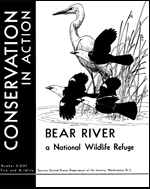United States Fish and Wildlife Service

United States Fish and Wildlife Service: Publications
Date of this Version
2001
Abstract
The Columbia Fishery Resources Office conducted fish surveys at Nathan's Lake, a proposed component of Boyer Chute National Wildlife Refuge (NWR), in June 2001. Boyer Chute NWR is located in the Missouri River Floodplain about three miles north or Omaha, NE and four miles southeast of Ft. Calhoun, NE.
Nathan's Lake is located about one mile southwest of Boyer Chute (Figure 1) in Washington County and is connected to the Missouri River by a drainage ditch with a control structure located at the northeast corner of the lake, Nathan's Lake is approximately a 50-acre shallow lake (0.61-1.22-m) that contains aquatic vegetation throught much of the lake and along its entire border. However, little vegetation was present in the northeast portion of the lake where a deep area (2.44-3.05-m deep) was excavated to provide overwintering habitat fo fish. Because Nathan's Lake is shallow, the temperature will vary over short periods of time. The temperature of the lake during sampling was 26 °C.
Nathan's Lake was formerly a productive lake with a successful fishery. Anglers harvested many desirable fish species from the lake, including black crappie (Pomixis nigromaculatus), white crappie (Pomoixis annularis), and channel catfish (Ictalurus punctatus)(Mike Ellis, personal communication). Recently, the lake had filled with sediment and dried up the eliminating fish habitat. Nathan's Lake is now part of a restoration project to restore the natural functions and native species of Missouri River floodplain wetlands. The lake and its water control structures were redesigned to attract waterfowl and create a spawning habitat for Missouri River fish. Nathan's Lake remained dry until early spring 2001 when it received Missouri River Water diverted through a water level control ditch to receive base flows and high flows from Deer Creek. A regraded dirch in the northeast corner of Nathan's Lake allows high water in the lake to flow back into Deer Creek. This survey was conducted to inventory and characterize the fish community of Nathan's Lake present after the restoration and spring flooding.


Comments
Published by the U.S. Fish and Wildlife Service